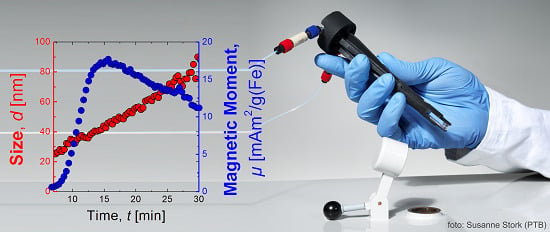Hyphenation of Field-Flow Fractionation and Magnetic Particle Spectroscopy
Abstract
:1. Introduction
2. Experimental Section
2.1. Samples
| Sample | hydrodynamic size Rhyd (nm) a | magnetic moment µm × 10−20 (Am2) b | saturation magnetization Ms (kA/m) | core type |
|---|---|---|---|---|
| Ferucarbotran (FER) | 26.85(5) | 4.2(7) c | 416(5) | single/multi |
| Fluidmag-D/30 (FM-30) | 14.7(1) | 9.8(6) | 310(2) | single |
| Fluidmag-D/50 (FM-50) | 30.6(3) | 25.8(2) | 360(30) | single |
| Fluidmag-D/100 (FM-100) | 64.0(5) | 17.9(1) | 270(20) | multi |
| Fluidmag-D/200 (FM-200) | 93.5(5) | 11.6(1) | 380(30) | multi |
| Fluidmag-D/300 (FM-300) | 127(2) | 15.0(1) | 370(30) | multi |
2.2. Magnetic Particle Spectroscopy (MPS)
2.3. MPS Continuous Flow Measurements
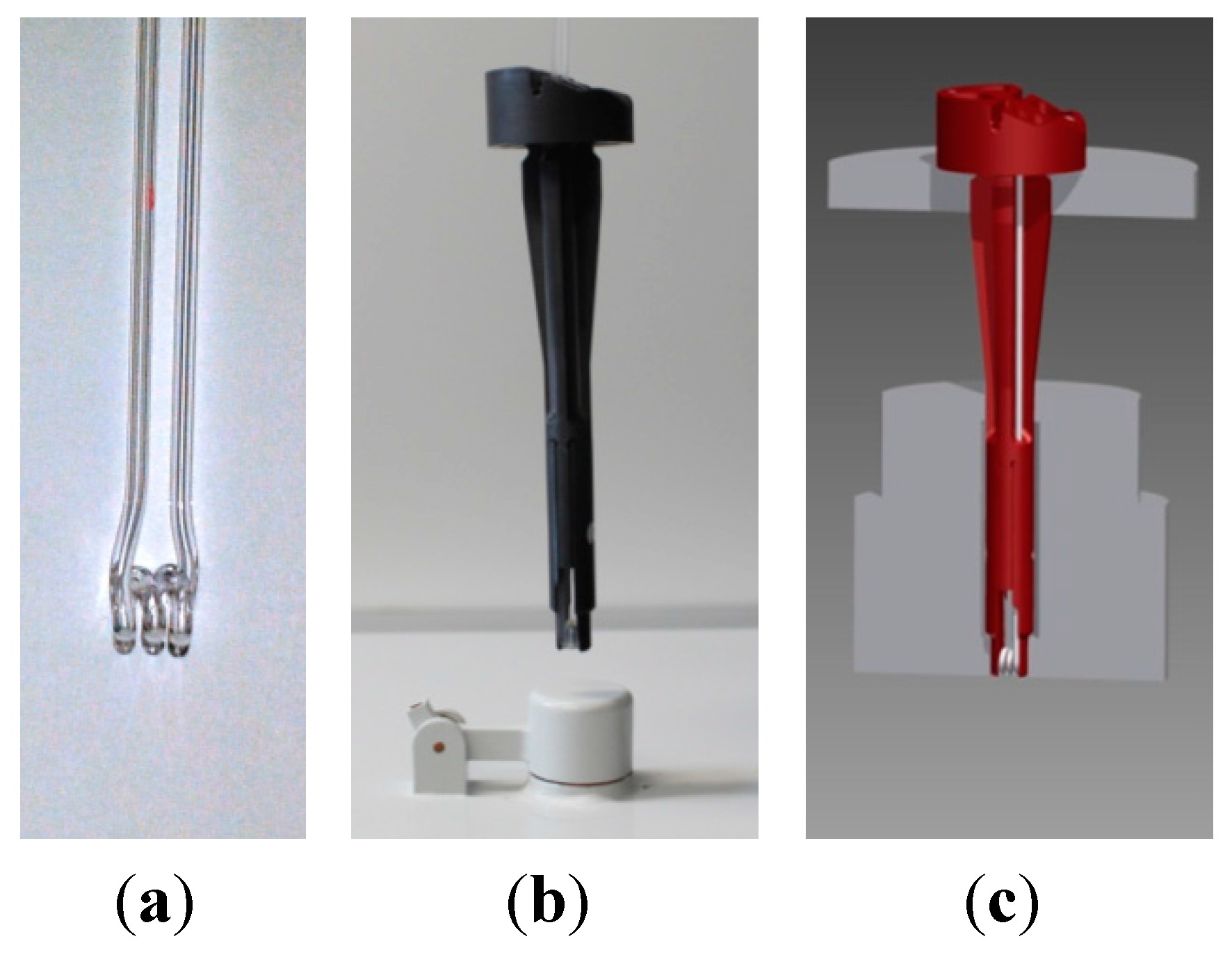
| Flow cell | Inner diameter (mm) | Veff (µL) | Material |
|---|---|---|---|
| FC2 | 0.5 | 10.1(3) | quartz glass |
| FC3L | 0.8 | 29(1) | polytetrafluoroethylene |
| FC3XL | 1.0 | 53(2) | silicone |
2.4. Asymmetric Flow Field-Flow Fractionation (A4F)
| Parameter | Setting |
|---|---|
| detector flow rate | 0.1 mL/min |
| slot outlet flow rate | 0.4 mL/min |
| cross flow rate | 1.5 mL/min (end: 0.1 mL/min) |
| injection and focusing | 4 min |
| cross flow gradient time | 20 min (starting from 14 min elution) |
3. Results and Discussion
3.1. Influence of MNP Structure
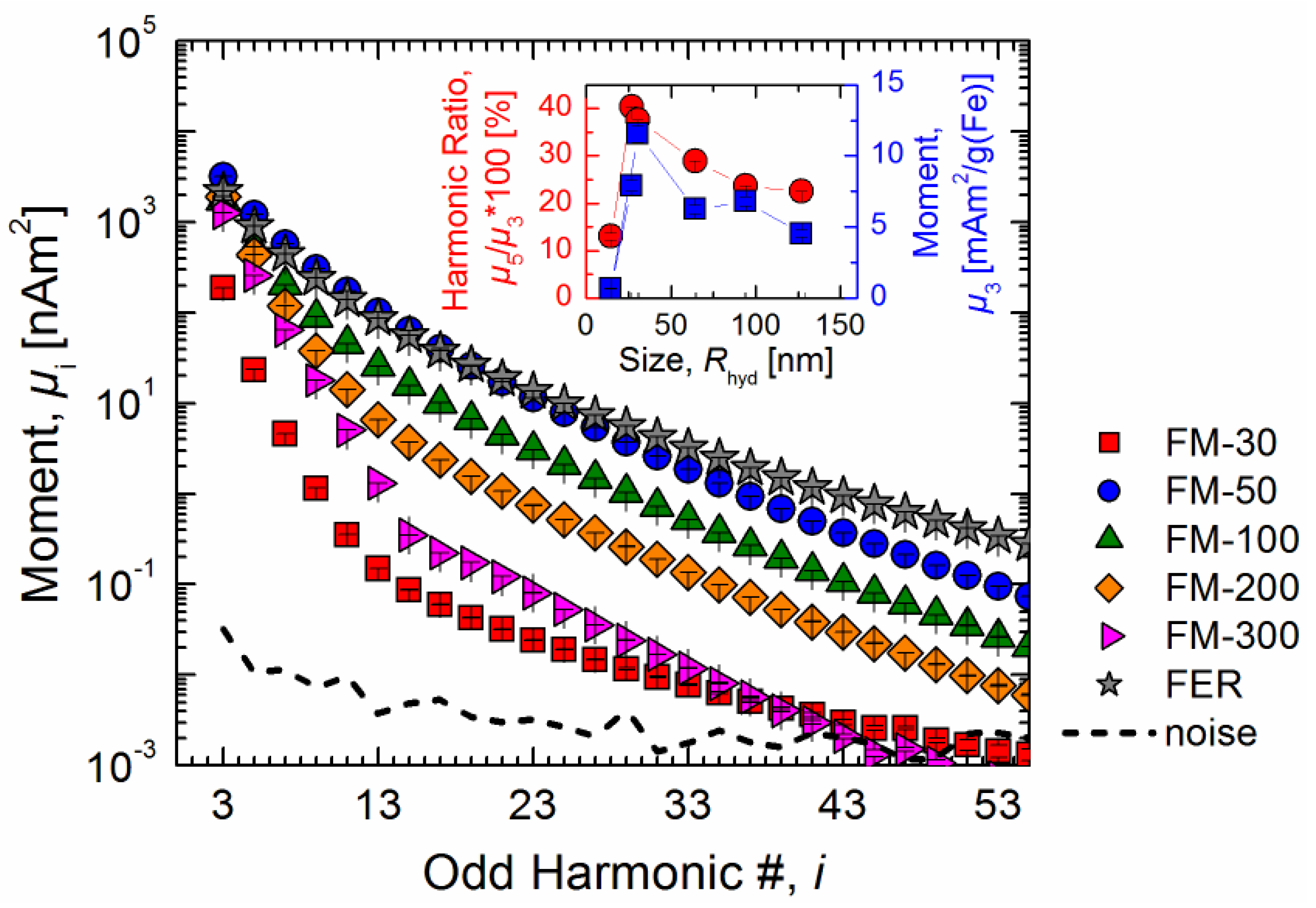
3.2. Influence of Dilution
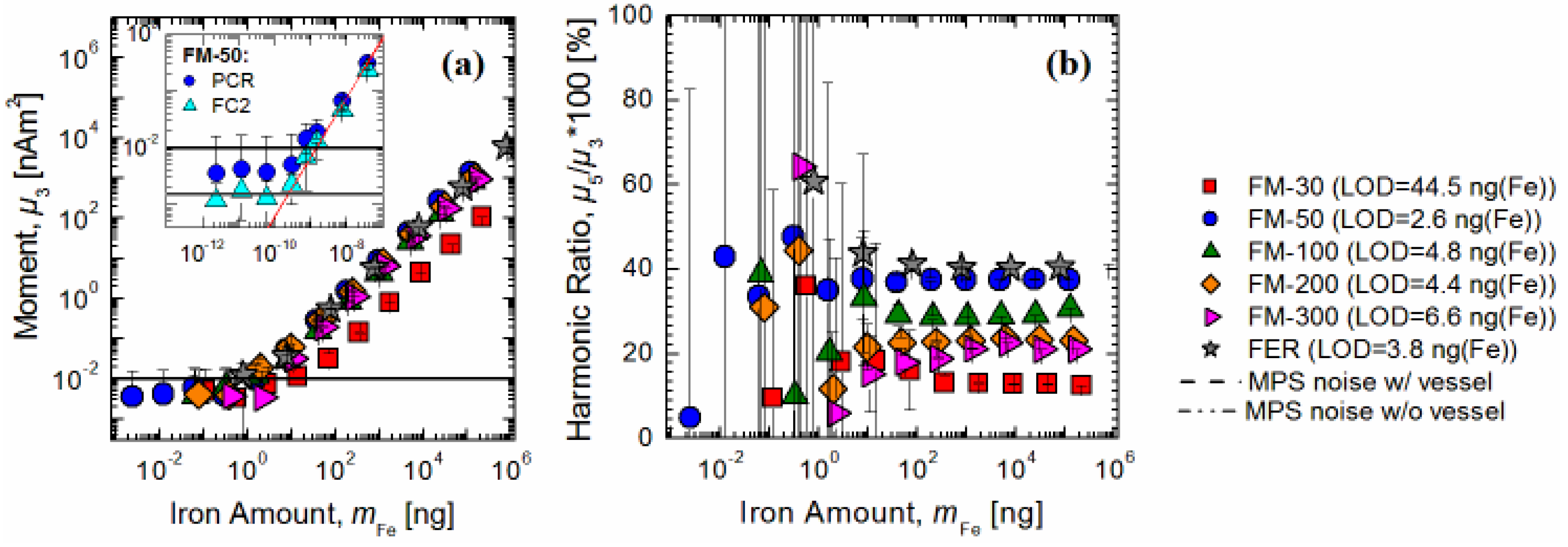
3.3. Influence of Excitation Field
3.4. Influence of Flow Rate


3.5. MPS Online Detection
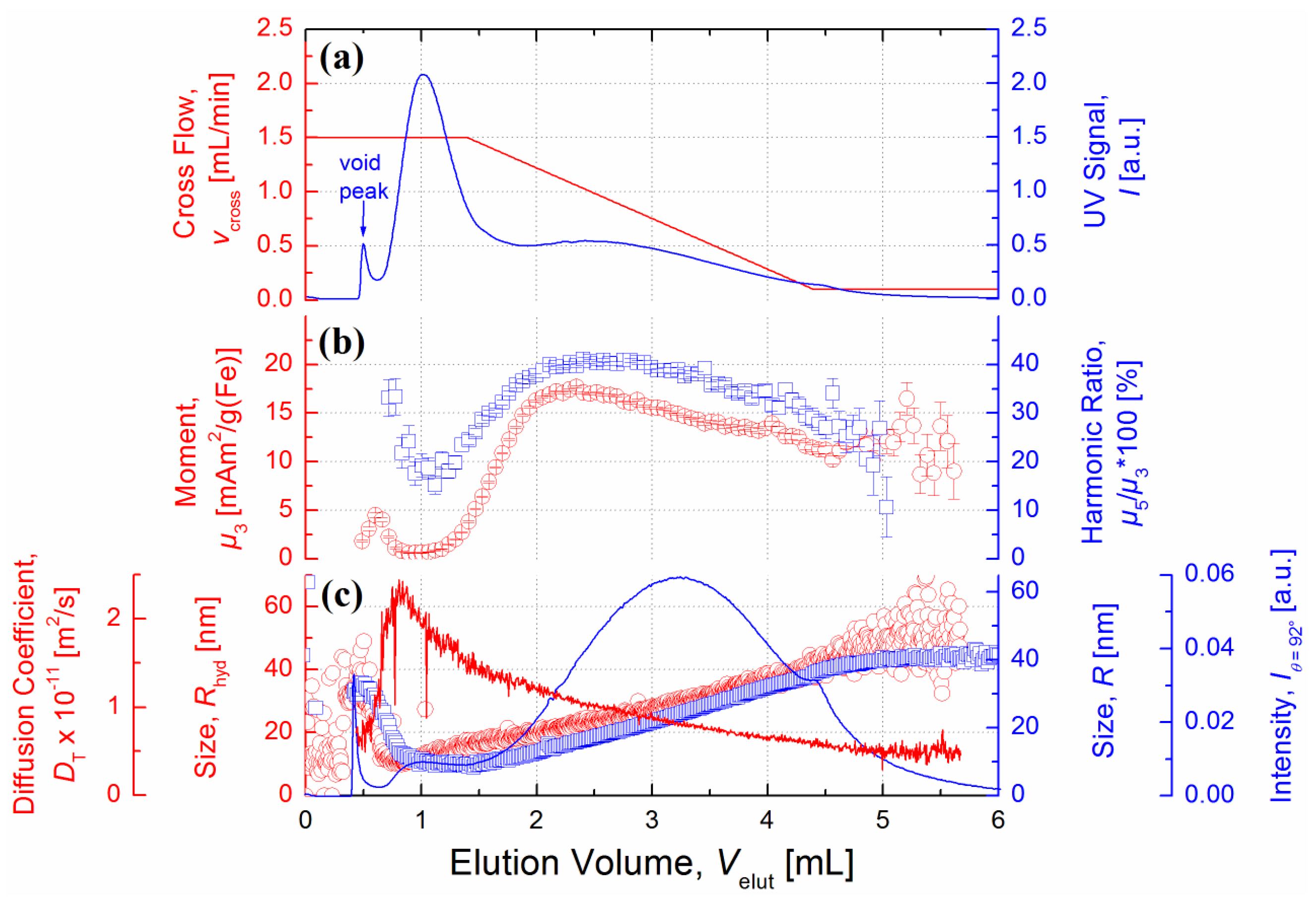
4. Summary and Conclusions
Acknowledgments
Author Contributions
Conflicts of Interest
References
- Goya, G.F.; Grazu, V.; Ibarra, M.R. Magnetic nanoparticles for cancer therapy. Curr. Nanosci. 2008, 4, 1–16. [Google Scholar] [CrossRef]
- Pankhurst, Q.A.; Connolly, J.; Jones, S.K. Applications of magnetic nanoparticles in biomedicine. J. Phys. D 2003, 36, R167. [Google Scholar] [CrossRef]
- Ittrich, H.; Peldschus, K.; Raabe, N.; Kaul, M.; Adam, G. Superparamagnetic iron oxide nanoparticles in biomedicine: Applications and developments in diagnostics and therapy. Rofo 2013, 185, 1149–1166. [Google Scholar] [CrossRef] [PubMed]
- Dennis, C.L.; Krycka, L.K.; Borchers, J.A.; Desautels, R.D.; van Lierop, J.; Huls, N.F.; Jackson, J.; Gruettner, C.; Ivkov, R. Internal magnetic structure of nanoparticles dominates time-dependent relaxation processes in a magnetic field. Adv. Funct. Mater. 2015, 25, 4300–4311. [Google Scholar] [CrossRef]
- Yu, S.S.; Lau, C.M.; Thomas, S.N.; Jerome, W.G.; Maron, D.J.; Dickerson, J.H.; Hubbel, J.A.; Giogio, T.D. Size-and charge-dependent non-specific uptake of PEGylated nanoparticles by macrophages. Int. J. Nanomed. 2012, 7, 799. [Google Scholar] [CrossRef] [PubMed]
- Huang, J.; Bu, L.; Xie, J.; Chen, K.; Cheng, Z.; Li, X.; Chen, X. Effects of nanoparticle size on cellular uptake and liver MRI with polyvinylpyrrolidone-coated iron oxide nanoparticles. ACS Nano 2010, 4, 7151–7160. [Google Scholar] [CrossRef] [PubMed]
- Willard, M.A.; Kurihara, L.K.; Carpenter, E.E.; Calvin, S.; Harris, V.G. Chemically prepared magnetic nanoparticles. Int. Mater. Rev. 2004, 49, 125–170. [Google Scholar] [CrossRef]
- Kratz, H.; Eberbeck, D.; Wagner, S.; Taupitz, M.; Schnorr, J. Synthetic routes to magnetic nanoparticles for MPI. Biomed. Biomed. Eng. 2013, 58, 509–515. [Google Scholar] [CrossRef] [PubMed]
- Luigjes, B.; Woudenberg, S.M.; de Groot, R.; Meeldijk, J.D.; Torres Galvis, H.M.; de Jong, K.P.; Philipse, A.P.; Erné, B.H. Diverging geometric and magnetic size distributions of iron oxide nanocrystals. J. Phys. Chem. C 2011, 115, 14598–14605. [Google Scholar] [CrossRef]
- Janca, J. Field-Flow Fractionation: Analysis of Macromolecules and Particles; M. Dekker Inc: New York, NY, USA, 1988; pp. 1–336. [Google Scholar]
- Lespes, G.; Gigault, J. Hyphenated analytical techniques for multidimensional characterisation of submicron particles: A review. Anal. Chim. Acta 2011, 692, 26–41. [Google Scholar] [CrossRef] [PubMed]
- Gleich, B.; Weizenecker, J. Tomographic imaging using the nonlinear response of magnetic particles. Nature 2005, 435, 1214–1217. [Google Scholar] [CrossRef] [PubMed]
- Weizenecker, J.; Gleich, B.; Rahmer, J.; Borgert, J. Micro-magnetic simulation study on the magnetic particle imaging performance of anisotropic mono-domain particles. Phys. Med. Biol. 2012, 57, 7317. [Google Scholar] [CrossRef] [PubMed]
- Ludwig, F.; Remmer, H.; Kuhlmann, C.; Wawrzik, T.; Arami, H.; Ferguson, R.M.; Krishnan, K.M. Self-consistent magnetic properties of magnetite tracers optimized for magnetic particle imaging measured by ac susceptometry, magnetorelaxometry and magnetic particle spectroscopy. J. Magnet. Magnet. Mater. 2014, 360, 169–173. [Google Scholar] [CrossRef] [PubMed]
- Graeser, M.; Bente, K.; Buzug, T.M. Dynamic single-domain particle model for magnetite particles with combined crystalline and shape anisotropy. J. Phys. D 2015, 48, 275001. [Google Scholar] [CrossRef]
- Wawrzik, T.; Yoshida, T.; Schilling, M.; Ludwig, F. Debye-based frequency-domain magnetization model for magnetic nanoparticles in magnetic particle spectroscopy. IEEE Trans. Magnet. 2015, 51, 1–4. [Google Scholar] [CrossRef]
- Deissler, R.J.; Wu, Y.; Martens, M.A. Dependence of Brownian and Néel relaxation times on magnetic field strength. Med. Phys. 2014, 41, 012301. [Google Scholar] [CrossRef] [PubMed]
- Wawrzik, T.; Ludwig, F.; Schilling, M. Multivariate magnetic particle spectroscopy for magnetic nanoparticle characterization. AIP Conference Proceedings 2010, 1311, 267–270. [Google Scholar]
- Dutz, S.; Kuntsche, J.; Eberbeck, D.; Müller, R.; Zeisberger, M. Asymmetric flow field-flow fractionation of superferrimagnetic iron oxide multicore nanoparticles. Nanotechnology 2012, 23, 355701. [Google Scholar] [CrossRef] [PubMed]
- Thünemann, A.F.; Rolf, S.; Knappe, P.; Weidner, S. In situ analysis of a bimodal size distribution of superparamagnetic nanoparticles. Anal. Chem. 2008, 81, 296–301. [Google Scholar] [CrossRef] [PubMed]
- Lohrke, J. Herstellung und Charakterisierung neuer nanopartikulärer SPIO-Kontrastmittel für die Magnetresonanztomographie. Ph.D. Thesis, University of Halle, Faculty of Natural Science, 2010. [Google Scholar]
- Löwa, N.; Knappe, P.; Wiekhorst, F.; Eberbeck, D.; Thünemann, A.F.; Trahms, L. Hydrodynamic and magnetic fractionation of superparamagnetic nanoparticles for magnetic particle imaging. J. Magnet. Magnet. Mater. 2015, 380, 266–270. [Google Scholar] [CrossRef]
- Löwa, N.; Knappe, P.; Wiekhorst, F.; Eberbeck, D.; Thunemann, A.F.; Trahms, L. How Hydrodynamic Fractionation Influences MPI Performance of Resovist. IEEE Trans. Magnet. 2015, 51, 1–4. [Google Scholar] [CrossRef]
- Berkov, D.V.; Görnert, P.; Buske, N.; Gansau, C.; Mueller, J.; Giersig, M.; Neumann, W.; Su, D. New method for the determination of the particle magnetic moment distribution in a ferrofluid. J. Phys. D 2000, 33, 1–7. [Google Scholar] [CrossRef]
- Eberbeck, D.; Wiekhorst, F.; Wagner, S.; Trahms, L. How the size distribution of magnetic nanoparticles determines their magnetic particle imaging performance. Appl. Phys. Lett. 2011, 98, 182502. [Google Scholar] [CrossRef]
- Snyder, S.R.; Heinen, U. Characterization of magnetic nanoparticles for therapy and diagnostics. Bruker BioSpin: Ettlingen, Germany, 2010. Available online: https://www.bruker.com/fileadmin/user_upload/8‑PDF‑docs/MagneticResonance/MRI/brochures/MPS_app‑note.pdf (accessed on 31 July 2015).
- Ferguson, M.R.; Khandhar, A.P.; Krishnan, K.M. Tracer design for magnetic particle imaging (invited). J. Appl. Phys. 2012, 111, 07B318. [Google Scholar] [CrossRef] [PubMed]
© 2015 by the authors; licensee MDPI, Basel, Switzerland. This article is an open access article distributed under the terms and conditions of the Creative Commons Attribution license (http://creativecommons.org/licenses/by/4.0/).
Share and Cite
Löwa, N.; Radon, P.; Gutkelch, D.; August, R.; Wiekhorst, F. Hyphenation of Field-Flow Fractionation and Magnetic Particle Spectroscopy. Chromatography 2015, 2, 655-668. https://doi.org/10.3390/chromatography2040655
Löwa N, Radon P, Gutkelch D, August R, Wiekhorst F. Hyphenation of Field-Flow Fractionation and Magnetic Particle Spectroscopy. Chromatography. 2015; 2(4):655-668. https://doi.org/10.3390/chromatography2040655
Chicago/Turabian StyleLöwa, Norbert, Patricia Radon, Dirk Gutkelch, Rinaldo August, and Frank Wiekhorst. 2015. "Hyphenation of Field-Flow Fractionation and Magnetic Particle Spectroscopy" Chromatography 2, no. 4: 655-668. https://doi.org/10.3390/chromatography2040655
APA StyleLöwa, N., Radon, P., Gutkelch, D., August, R., & Wiekhorst, F. (2015). Hyphenation of Field-Flow Fractionation and Magnetic Particle Spectroscopy. Chromatography, 2(4), 655-668. https://doi.org/10.3390/chromatography2040655





